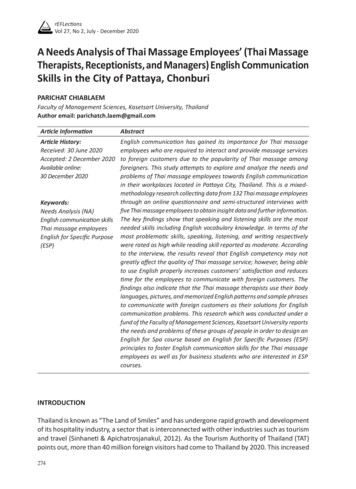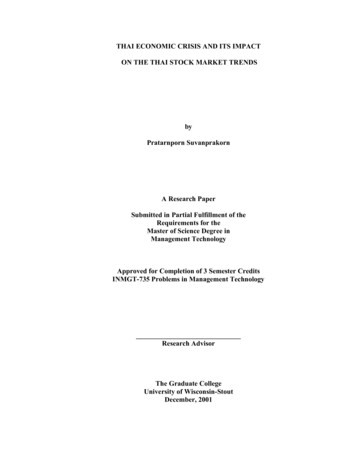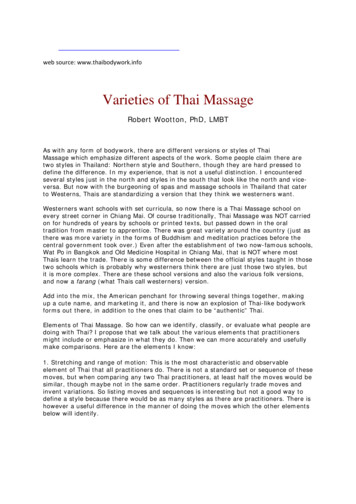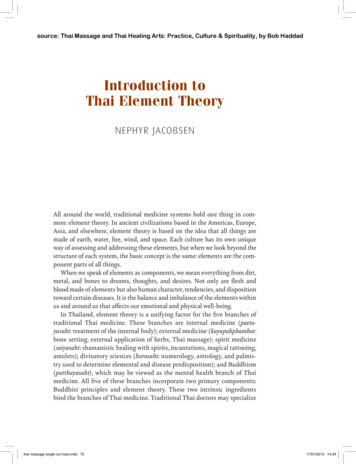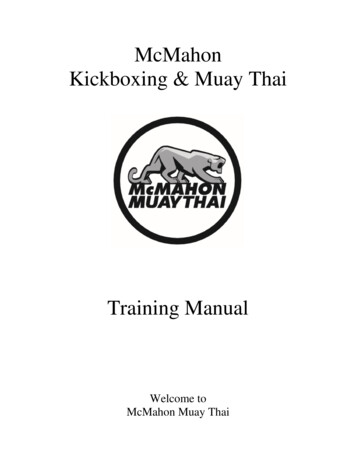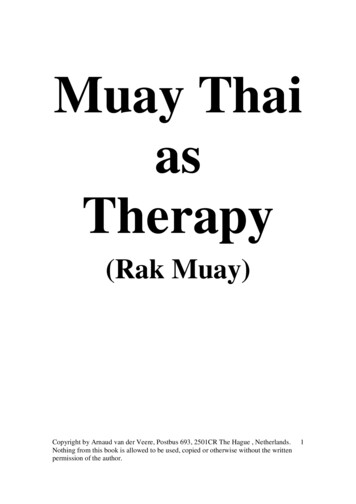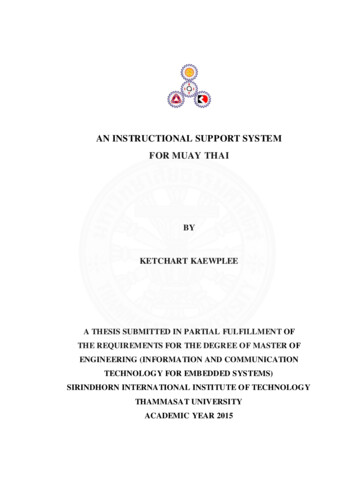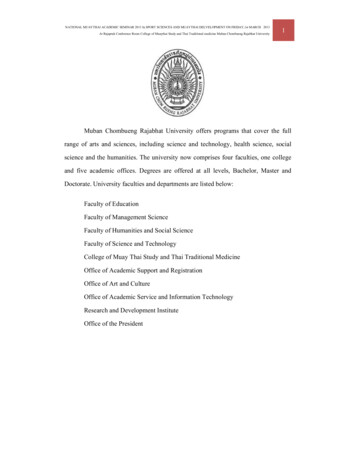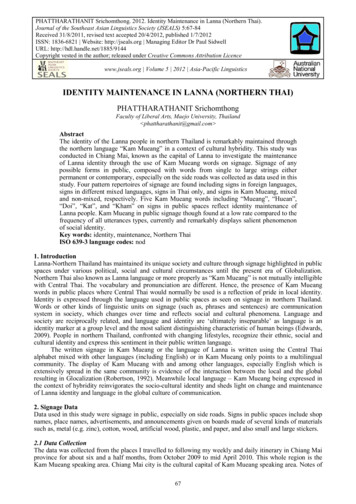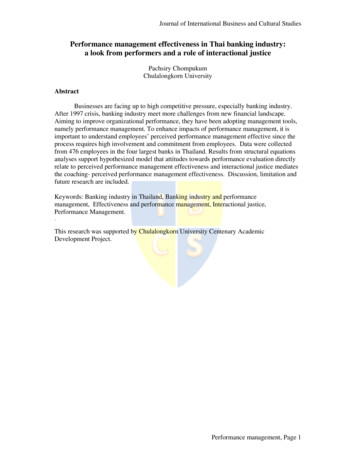
Transcription
Journal of International Business and Cultural StudiesPerformance management effectiveness in Thai banking industry:a look from performers and a role of interactional justicePachsiry ChompukumChulalongkorn UniversityAbstractBusinesses are facing up to high competitive pressure, especially banking industry.After 1997 crisis, banking industry meet more challenges from new financial landscape.Aiming to improve organizational performance, they have been adopting management tools,namely performance management. To enhance impacts of performance management, it isimportant to understand employees’ perceived performance management effective since theprocess requires high involvement and commitment from employees. Data were collectedfrom 476 employees in the four largest banks in Thailand. Results from structural equationsanalyses support hypothesized model that attitudes towards performance evaluation directlyrelate to perceived performance management effectiveness and interactional justice mediatesthe coaching- perceived performance management effectiveness. Discussion, limitation andfuture research are included.Keywords: Banking industry in Thailand, Banking industry and performancemanagement, Effectiveness and performance management, Interactional justice,Performance Management.This research was supported by Chulalongkorn University Centenary AcademicDevelopment Project.Performance management, Page 1
Journal of International Business and Cultural StudiesINTRODUCTIONThe increasingly competitive environment of the 1980s, which continued throughoutthe recessionary 1990s still remains a dominant factor today. Up until now, the increasingcompetition is even higher than one could imagine. Business faces challenging of increasingintensity and scope of globalization, a drive to comply with international standards, acontinued move toward automation of production processes, a reliance on more sophisticatedinformation technologies, and unrelenting increase of oil price.Banking industry in Thailand is one of the industries that are facing up to highcompetitive pressure, especially after 1997 crisis. As showed in the Figure 1, as indicated inFigure 1 (Appendix B) net profits and return on assets sunk during the crisis. It was not until2001 that the net profit of the banks became slightly positive gain.Although the economic situation in Thailand is recovering, banking industry meetsmore challenges from new financial landscape such as Basel II implementation and FinancialSector Master Plan. As a result, it has introduced additional competitive pressure to theindustry. Thailand now welcome foreign investors to hold major shares in Thai banks, i.e.ABN Amro, DBS Bank, United Overseas Bank, and Standard Chartered Bank. Therefore, tosurvive in the midst of high competition, all banks have to reform their revenues and coststructures (Sookpradist, 2003). For income enhancement, it can offer services that otherbanks have not yet provided and increase non-interest income such as fee income from debtinstrument transactions and foreign exchange transactions. However, for cost reduction, allbank seem to have the same cost for capital because of regulations from Bank of Thailandand market mechanism. Thus, it looks like the only way for bank to reduce cost is to operateat a relatively lower cost than competitors. By banking nature, operating expenses, includingsalaries consumes about half of total revenue (Payant, 2006). Managing these operationalactivities and their associated costs wisely can improve profitability.To thrive or survive, banks need to continuously improve qualities, attract morecustomers, and are more cost- conscious. In other words, banks need to better manage theirperformance. Over the years, there are many practices, tools, techniques, systems,philosophies that aim to help organizations to gain competitive advantage. Some of them areproved to be effective and remain in the business management while some of them may bejust a business fad. Among the effective one, performance management is a prominentpractice that help organizations to create business value. For instance, in a survey of 437 U.S.companies, McDonald, Shield, and Smith (Rheem, 1995), found that companies that usedperformance management programs had greater profits, better cash flow, stronger stockmarket performance, and greater stock value than companies that did not. In addition,companies with such programs had higher sales per employee or productivity- than those thatdid not; also, productivity and financial performance in companies with performancemanagement program were higher relative to other companies in their industries. In the samestudy, they also compared companies before-and- after implementing the program. Theyfound that after implementing performance management, total shareholder return increasedby 24.8% and productivity increased by 94.2%.Not surprisingly, many banks in Thailand are vigorously implementing performancemanagement system to help them better manage their employee’s performance and in turn,it affects organizational performance. Since it is the key process through which work isaccomplished, it is considered the “Achilles Heel” of managing human capital(Pulakos, 2009). Therefore, it is very important to manage it effectively.Having performance management system in banks does not guarantee desiredoutcomes, namely its effectiveness. For example, when executives were asked to commenton their own performance management programs, they rated the programs as only “slightlyPerformance management, Page 2
Journal of International Business and Cultural Studieseffective” to “somewhat effective” (2 and 3 on a scale of 1 to 4) (Rheem, 1995). In anotherstudy conducted by WorldatWork and Sibson Consulting, it is found that only 5% ofrespondents gave an A to their performance management effectiveness and 46% rated theircompanies performance effectiveness as B (Anonymous, 2007). Employees’ perceptiontoward the program can shape how they react to and act in accordance with the performancemanagement system. Since performance management is the process that requires highinvolvement and commitment from people in the organization, perceptions of the employeescan highly affect organization outcome. Therefore, the purpose of this paper is to explorehow employees in commercial banks perceive effectiveness of performance management andfactors affecting levels of perceived performance management effectiveness.THAI BANKING INDUSTRYBank of Thailand classifies commercial banks in Thailand into two groups, commercialbanks registered in Thailand and foreign banks (full branch). Due to their assets size andmarket share, commercial banks registered in Thailand are considered as the most importantand influenced business of the country. Since commercial banks mobilize the savings alsobeing the largest source of loans. Furthermore, banking industry has roles to supportmonetary policy such as to increase or decrease money in the market. The government alsouses the commercial banks as the key instrument in order to drive monetary policy andbalancing the economy appropriately. According to the statistics from Bank of Thailand asof August 2011, there are 17 commercial banks registered in Thailand as shown in Table 1, asindicated in Table 1 (Appendix A).According to Chunhachinda and Li (2010), Since the 1997 crisis, there are a couple ofmajor changes; the ownership structure has changed dramatically due to the lift of foreignlimit control by the Bank of Thailand and the banking industry began taking higher marketrisks after the crisis causing the percentage of non-interest income to interest income toincrease substantially. Competition in the industry is very high. It drives banks to find waysto increase their income and profit. The Bank of Thailand warned them that high competitionin corporate lending could eventually cause a deterioration of credit quality (2011). There isalso depressed margin. As shown in Figure 2, as indicated in Figure 2 (Appendix B).margins have fallen from 3.6% in the beginning of 2008 to 3.1% by the end-2010 (2011).Currently big banks such as Bangkok Bank and Kasikorn Bank, are trying to searchfor better opportunities by investing in foreign countries. Besides expanding to overseas,banks are trying to seeking for ways to increase their efficiency, including managingemployee performance.THEORECTICAL BACKGROUND AND HYPOTHESEPerformance ManagementManaging performance has been a very important issue for a long time. It has gainedmore attention recently due to high competitive business environment. Especially when thepopularity of Balanced Score Card calls for mechanism to cascade and instill the corporatestrategy down through the organization and to ensure that strategy plan is actuallyimplemented, performance management is one of practices that assist organization to linkorganizational goals to individual goals. That is, operational goals take the organization’sstrategies and translate them into specific goals. Therefore, it facilities managementalignment and buy-in by bringing all levels of management into operational planning processPerformance management, Page 3
Journal of International Business and Cultural Studiesand giving employees a chance to help shape the plan (Aguilar, 2003). It focuses on ways tomotivate employees to improve their performance (DeNisi and Pritchard, 2006).Furthermore, it can help organizations to improve financial performance. A studyconducted by McDonald and Shield of Hewitt Associates found that companies that usedperformance management programs had greater profits, better cash flow, stronger stockmarket performance and greater stock value than companies that did not. Not onlyperformance management improved financial performance, but it also improved productivity;companies with such programs had higher sales per employees (Rheem, 1995).Nonetheless, performance management has been mistaken as performance evaluation.As a matter of fact, both performance management and performance evaluation are relatedbut they are not exactly the same concept. Performance management is a systematic processfor improving organizational performance by developing the performance of individuals andteams; it is a mean of getting better results from the organization, teams, and individuals byunderstanding and managing performance within an agreed framework of planned goals,standards, and competence requirement (Armstrong, 2006). While performance evaluation isa process of assess and rate past performance of individuals or groups (Oct 2004).Performance evaluation is just a part of performance management. Table 2 comparesperformance evaluation with performance management, as indicated in Table 2 (Appendix A).Not only performance management is mistaken as performance evaluation, it is alsomisunderstood especially by human resource practitioner and managers. It can results inmisperception of employees and affect performance management effectiveness. In a reviewof literature on this topic, London, Mone, and Scott (2004 ), propose that there are severalproblems regarding using performance management which are (1) the misuse of methods,poor program development, and lack of program evaluation, (2) the mismatch betweenperformance management system and organizational context, (3) failure of choosing the rightmethod for the right purpose i.e. using multisource rating for administration instead ofdevelopment (4) wrong criteria to evaluate performance management and (5) carelessimplementation with little attention to interpersonal dynamics and psychometric testing.All in all, performance management reflects a paradigm shift from thinking ofperformance evaluation as a discrete event to a continuous process (Latham and Mann, 2006).Specifically, performance management encompasses the entire range of enhancingperformance. It includes an approach to creating a shared vision of the organizational goalsand objectives, aiding employees to understand and know their part in contributing to themand implementing linkage between performance and reward (Fletcher, 1996).Overall, performance management aims to (Armstrong, 2006): Empower, motivate and reward employees to do their best Focus employees’ tasks on the right things and doing them right; aligneveryone’s individual goals to the goals of the organization Proactively manage and resource performance against agreed accountabilitiesand objectives Align personal/individual objectives with team, department and corporate plan. Make individuals clear about what they need to achieve and expectedstandards, and how that contributes to overall success of the organization Provide regular, fair, accurate feedback and coaching to stretch and motivateemployees to achieve their best Maximize the potential of individuals and teams to benefit themselves andorganizations.Performance management should not be viewed as a mechanistic system based onperiodical formal evaluations and detailed documentation. It is ongoing communicationbetween manager and employees. Effective performance management entails a process wherePerformance management, Page 4
Journal of International Business and Cultural Studiesemployees are fully aware of their roles in the organization, the type of output expected, andhow the output will be measured (Ramlall, 2003). The processes of performance managementconsist of:Performance planning/Goal settingIt involves cascading organizational goals to individual goals, agreeing objectives,competency requirements, and personal development plans.Performance management is amechanism to join together individuals’ performance with an organizational performancethrough aligning organizational goals with individual goals. It is used to create a sharedvision and goals of the organization, and to help each individual employee to understand andrecognize their part in contributing to organizational performance (Fletcher,1993). Onceorganizational goals have been set, they are cascaded down through the organization.Goal setting theory (Locke and Latham, 2002) states that a goal drives performance.It affects direction, effort and persistence of employees. Specifically, a goal directs anemployee’s attention toward actions which bring goal accomplishment, leads an employee toadjust and persists their effort, and stimulates the development of task strategies to attain it.However, to enhance effectiveness, goals should be specific and difficult (Seijts and Latham2005). In the other words, a specific and challenging goal leads to higher performance thangeneral goals such as “do your best”. In fact, it has much stronger effect on performance thanany other factors, including participation. It may be presumed that participating in goalsetting enhance its effectiveness; goal setting is likely to be more effective when peopleparticipate in setting goals than when goals are assigned to them. However, Locke andLatham (2002) state that when goal difficult is held constant, the performance of those whoparticipate in setting goals does not differ significantly from those who were assigned goals.Moreover, both a participatively set goal and an assigned goal result in higher performancethan a general goal asking employees to do their best (Latham, Steele, and Saari, 1982).Clearly, goal setting has motivational effect on employees. But this does not mean that itaffects employees’ attitude toward performance management system since having goals doesnot directly affect employees’ gain and loss. In fact, in their exploratory research, Taylor andPierce (Taylor and Pierce, 1999) found that it did not matter employees had goals or not;all employees who received a lower-than-expected performance evaluation blamed eithertheir supervisor, the organization, or performance management system.Acting: CoachingCoaching will help employees to maximize their full contribution and potential. It isprocess through which supervisors may communicate clear expectations to employees,provide feedback and give suggestions to employees. It also prepare employees to be readyfor challenging works (Heslin, VandeWalle and Latham, 2006). It is an important mechanismthat helps supervisors enhance employees’ performance. For example, Liu and Batt (2010)found that amount of coaching that an employee received each month predicted objectiveperformance improvement over time. In a study of effects of managers’ coaching intensity onthe performance of those they supervise, at multiple levels of an organizational hierarchy, it isfound that managers’ coaching intensity influences the performance of their subordinatesafter controlling for job satisfaction (Agarwal, Angst, and Magni, 2009).To increase its effectiveness, coaching should be done on an ongoing basis; this mayinclude regular coaching meeting in formal performance review session where supervisorsreview recent performance, evaluate it, and provide guidance, suggestions, andrecommendations for improvement; additionally, it may include less formal discussionsPerformance management, Page 5
Journal of International Business and Cultural Studiesbetween supervisors and employees concerning performance (Lindbom, 2007). In fact, trulyeffective managers and managerial leaders are those who embed effective coaching into theheart of their managerial practice (Hamlin, Ellinger, and Beattie, 2006). However, coachingis not only performed by managers. It can be performed by peers (Armstrong, 2006). Peerscan support one another’s learning and development by providing emotional and technicalsupport. Parker, Hall, and Kram (2008) propose that peer coaching will be very effective if ithappens through a 3-step process of (1) building the development relationships, (2) creatingsuccess in development, and (3) internalizing the learning tactic by applying the peercoaching process in future relationships.REVIEWING: Performance Evaluation and Linkage Performance to Rewards.Performance evaluation usually takes place in a yearly or semi-yearly session. Aneffective performance evaluation should accurately outline employees’ responsibilities andcontributions to organizations (Clausen, Jones, and Rich, 2008) and be free from errors suchas leniency, halo effect, and range restriction. Not surprisingly, research on the topics of rateraccuracy and measurement are in the mainstream of organizational psychology. However,DeNisi and Pritchard (2006) believe that performance evaluation research were too interestedin measurement issues and not interested enough in ways to improve performance. To so do,research on employee reactions is very important because what employees perceive can affecttheir behavior and performance.There are two main purposes of performance evaluation, namely for human resourcemanagement and for human resource development. For human resource management,performance evaluation can serve as a valuable input to make administrative decisionsrelating to promotions, firing, and merit pay increases (Byars and Rue, 2004). In the otherwords, results of performance evaluation will link to reward of individual to motivate andstimulate employees to perform better and show how much employers recognize theirperformance. In addition, information from performance evaluation can provide neededinput for employee development, including coaching. Therefore, both linkage between andperformance and reward and coaching are associated with performance evaluation. This leadsto:Hypothesis1: Performers’ attitude towards performance evaluation is positively related tolinkage between consequences and targeted performance.Hypothesis 2: Coaching is positively related to performers’ attitude toward performanceevaluation.Moreover, most employees expect coaching to be facilitative, supportive, and aimedat their own goals and needs (Peterson, 2009). Information that is given in the coachingprocess not only includes discussions of performance expectation, but also providingfeedback and motivating employees by stating desired consequences if their goals achieved.Thus, it is proposed:Hypothesis3: Coaching is positively related to linkage between consequences and targetedperformance.Effectiveness of Performance managementPerformance management does not necessarily deliver good results. Some ineffectiveperformance management can be a drain on employee morale and affect both employees’Performance management, Page 6
Journal of International Business and Cultural Studiesbehavior and a company’s ability to achieve its strategic objective. According to Lawson(Lawson, 1995), effective performance management means: It articulates organization’s vision. It establishes key results, objectives and measures at key business unit level. It identifies business process objectives and the key indicators of performance forthose processes. It identifies and installs effective departmental measures. It monitors and control four key performance measures namely quality, delivery,cycle time, and waste. It manages the continuous improvement of performance in those key area. It prepares to aim for breakthrough improvements in performance when this isrequired by a significant shortfall in performance measured against the performanceof major competitors.Performers’ PerceptionPerformance management is traditionally seen as management’s systematicapplication of processes aimed at fully utilizing human resources and it carries somewhatnegative connotation when considered from the performer’s perspective (Buchner, 2007).Hence, factors causing effectiveness can be different in the eyes of management andemployees. Due to the conflicting results of performance management benefits, organizationsshould pay more attention to the internal effects (Martinez and Kennerley, 2006). In theother words, it is important to consider how employees react to performance managementsystem. One factor that may affect employees’ perceived performance managementeffectiveness is their attitude towards performance evaluation. In review of performanceevaluation studies, Levy and Williams (2004) stated that appraisal reaction was important:employees were more likely to ignore information they received from their performanceevaluation when they perceived that the performance evaluation system is not fair and sourceof those information were not credible. Since performance evaluation is a source of input forperformance management process (DeNisi and Pritchard, 2006), attitudes towardperformance evaluation tend to affect attitudes towards performance managementeffectiveness. In addition, performance evaluation is one major elements of performancemanagement that directly have consequences on employees in many ways including theiradvancement and rewards. In fact, based on the survey results, it is suggested that the qualityof performance evaluation should be measured if organizations want to increase performancemanagement effectiveness (Oakes, 2007). Moreover, from another survey of performancemanagement, out of nine factors that are key practices that can lead to perceived performanceeffectiveness, there are five factors that is related to performance evaluation, i.e., plans forhelping employees develop in the work period after the evaluation, training for managers onhow to conduct a performance evaluation meeting, metrics of the quality of performanceevaluation, performance evaluation that is not limited to the judgment of supervisors, andconsistency of performance evaluation across the whole organization (2007). It leads to:Hypothesis4: Performers’ attitude toward performance evaluation is positively related toperceived performance management effectiveness.Mediating Role of Interactional JusticeBies and his colleagues introduced one form of justice, interactional justice. It focuseson the quality of interactions among peoples in the organizations. According to Greenberg(Greenberg, 1993) there are two main components of interactional justice which are qualityPerformance management, Page 7
Journal of International Business and Cultural Studiesof the treatment that the target receives and procedural explanations for why somethinghappened. More specially, the first component reflects the degree to which people are treatedwith politeness, dignity, and respect by authorities and the second component focuses on theexplanations provided to individuals that convey information about why procedures wereused in a certain way and why they received those outcomes. According to Fassina andColleagues (2008) people use the information they have a about the fairness of interpersonaltreatment to form impressions of fairness and these impressions have a causal effect on theirresponses. It is also found that interactional justice related to employee attitudes, namelysatisfaction and commitment (Cohen-Charash and Spector, 2001).It was argued that interactional justice more likely to affect individuals’ cognitive,affective, and behavioral reactions toward their supervisors than their reactions towardorganizations because supervisors were the direct source of justice (Cohen-Charash andSpector, 2001). A meta-analysis of justice found that interactional justice highly affectedagent-referenced outcomes, namely job satisfaction, organizational commitment, agentreferenced evaluation of authority, organizational citizenship behavior, and performance(Colquitt et al. 2001). As for performance management system, although it is one of anorganizational systems, employees are trained to believe that it is owned by their supervisors,not human resource department nor the organization. In addition, the essence of performancemanagement is communications between employees and their supervisors. Therefore, theirreactions toward perceived performance management effectiveness tend to be parallel theirreactions toward their supervisors. More specifically, interactional justice tends to lead toperceived performance management. Since interactional justice involves interpersonal andinformational components, it is likely to occur in the in coaching process. In the other words,when a supervisor engage in coaching processes, it leads to interactional justice and in turn, itleads to perceived performance management effectiveness. This leads to:Hypothesis 5: Interactional justice mediates the coaching – perceived performancemanagement effectiveness relationship. Specially, coaching is associated positively withinteractional justice. Interactional justice, in turn, is related to perceived performancemanagement effectiveness.The hypothesized model is depicted in Figure 3, as indicated in Figure 3 (Appendix B).METHODSampleBank of Thailand categorizes banks into 2 types, commercial banks registered inThailand and foreign bank branches. Since the size of each foreign bank branches is small,the study focuses only on the commercial banks registered in Thailand. Sample of the studyincluded employees in commercial banks registered in Thailand from various functions in thefour biggest banks. One reason of focusing on the biggest four big banks is that not all banksare formally implementing performance management. Only big banks that have solid humanresource department and resources to implement the system. Of the 600 questionnairesdistributed, 492 employees responded, yielding a response rate of 82%. 16 questionnaireswere not usable. The final response rate for the usable questionnaires was 79.3%. As shownin Table 3, as indicated in Table 3 (Appendix A), of the total 476 subjects, 58.4 % werefemale. The age of respondents ranged from 22 to 59 years, average age was 38.85. Morethan a half of respondents were single (59.9%). Most of respondents had a bachelor’s degree(44.7%) and a master’s degree (51.9%). In terms of tenure, 10.9% were less than 1 year,18.9% were between 1 to 3 years, 17.4% were between 3 to 6 years, 7.4% were between 6 to10 years, 13% were between 10 to 15 years, 16.4% were between 15 to 20 years, 9.5% werePerformance management, Page 8
Journal of International Business and Cultural Studiesbetween 20 to 25 years, and 6.3% were more than 25 years. Furthermore, most respondents(43.6%) have been working with current supervisors between 1 to 3 years.ProcedureQuestionnaires were sent out to employees by the organizations themselves, and the(anonymously) completed forms were returned to the researcher. Each subject was assuredof the confidentiality of his or her response. To encourage employees to participate in thestudy, it was also stated in the covered letter that for each questionnaire return, ten bahts willbe donated to Thai Red Cross Society.MeasuresQuestionnaires incorporated items from related research and applied a Likert 5-pointscale (1 ‘strongly disagree’ to 5 ‘strongly agree’) to explore levels of perceived performancemanagement effectiveness and mediating effects of procedural and informational justice. Theitems were first prepared in English, and then translated into Thai by a native speaker. Theconventional method of back-translation was used to translate the measures and discrepancieswere resolved by discussion (Brislin, Lonner, and Thorndike, 1973). Finally, the measureswere refined through in-depth interviews with HR senior managers/ directors in four banks toensure their relevance to a Thai context.Attitudes toward performance evaluation. Attitudes toward performance evaluation wasmeasured by the average of five items (α 0.886).Linkage between consequences and targeted performance. Three-item 5-point scale wereemployed to measure linkage between consequences and targeted performance (α 0.854).Coaching. Task support was measured in terms of coaching from their supervisor and peersby using 3 items measured on a 5-point scale (α 0.856).Interactional justice. The scale developed by Mooreman (Moorman 1991) was used tomeasure informational justice. There were six items (α 0.943).Perceived performance management effectiveness. The measure was develope
respondents gave an A to their performance management effectiveness and 46% rated their companies performance effectiveness as B (Anonymous, 2007). Employees' perception toward the program can shape how they react to and act in accordance with the performance management system. Since performance management is the process that requires high


